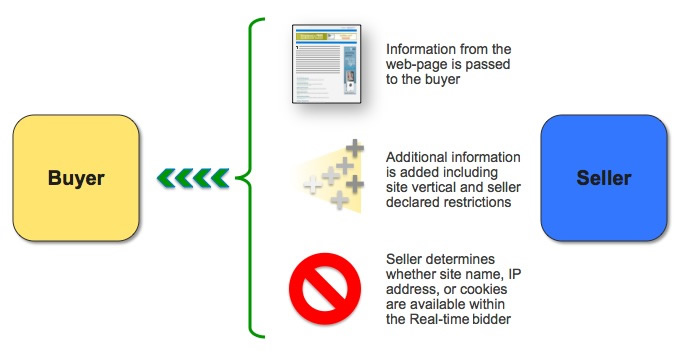Este guia oferece uma visão geral dos conceitos de lances em tempo real (RTB) necessários para escrever aplicativos de bidder que podem participar dos lances em tempo real do Authorized Buyers.
Noções básicas
Um aplicativo de bidder pode se comunicar com o Google usando um dos protocolos de RTB compatíveis. Uma solicitação de lance enviada a um aplicativo fornece contexto sobre pelo menos uma oportunidade de anúncio para que o bidder possa determinar o criativo e o valor do lance ideais (se houver) para cada impressão. Um bidder pode responder com uma resposta de lance para fazer pelo menos um lance e especificar o criativo a ser veiculado para as oportunidades de anúncio enviadas na solicitação.

O cenário a seguir é uma possível interação entre um aplicativo de bidder e o Authorized Buyers:
- O Google envia ao aplicativo do bidder uma solicitação de lance que descreve uma impressão em leilão. A conta do bidder está configurada para usar o OpenRTB no formato Protobuf. Portanto, a solicitação chega como um
BidRequestserializado, conforme mostrado em openrtb.proto. Para saber como seu aplicativo deve interpretar a solicitação de lance, consulte Processar a solicitação. -
O aplicativo do bidder analisa a solicitação e aplica a lógica de lances para criar um
BidResponseque inclui um lance e um criativo para a oportunidade de anúncio. Em seguida, o aplicativo serializa a resposta do lance e a envia ao Google. Para saber como seu aplicativo deve criar e retornar uma resposta de bid, consulte Como criar a resposta. -
A resposta do lance é recebida, e ele entra no leilão aberto, onde ganha a impressão porque é o lance mais alto. Como resultado, o criativo especificado na resposta é inserido.
Selecionar um protocolo
O protocolo de lances em tempo real especifica os indicadores que seu aplicativo pode usar para avaliar e dar lances em cada impressão enviada em uma solicitação, além de como construir uma resposta. Há duas maneiras de modificar o protocolo associado ao aplicativo do bidder:
- Entre em contato com seu gerente técnico de contas para mudar isso manualmente.
- Use a API REST do Authorized Buyers para mudar isso de maneira programática.
Protocolos compatíveis
O Authorized Buyers é compatível com dois protocolos de RTB:
- OpenRTB (Protobuf)
Uma implementação da especificação OpenRTB usando Protobuf.
- OpenRTB (JSON)
Uma implementação da especificação OpenRTB usando JSON.
Sobre os buffers de protocolo
O Protobuf é um formato de código aberto para representar e serializar informações estruturadas.
Se você quiser usar o OpenRTB Protobuf, instale o compilador de protocolo e o ambiente de execução do Protobuf para a linguagem escolhida. Em seguida, baixe os arquivos proto que você pretende usar e execute o compilador para gerar uma biblioteca que possa serializar ou desserializar mensagens definidas no proto, como BidRequest ou BidResponse. Esta
referência do Protobuf
mostra como fazer isso em várias linguagens.
Atualizações de protocolo
Os protocolos de RTB serão modificados à medida que o Google adicionar novos recursos e descontinuar outros. As mudanças serão anunciadas bem antes de entrarem em vigor, o que deve dar tempo suficiente para remover as dependências que seu aplicativo possa ter em campos programados para descontinuação. Para mais informações sobre como lidar com campos obsoletos, consulte Adaptação à obsolescência dos campos BidRequest.
Próximas etapas
O conteúdo a seguir oferece mais detalhes sobre os conceitos de lances em tempo real:
- Processar a solicitação: Como analisar e interpretar indicadores encontrados na maioria das solicitações de lances.
- Criar a resposta: como criar uma resposta de lance e campos especificados com frequência na resposta.
- Guia do OpenRTB: referência para a implementação da especificação OpenRTB pelo Authorized Buyers, além de extensões específicas do Authorized Buyers. Detalha casos extremos e limitações específicos dessa implementação e identifica campos equivalentes no protocolo do Google.
- Requisitos para veiculação de anúncios terceirizada: define as políticas que os bidders precisam obedecer para usar vários formatos de anúncio, bem como as especificações técnicas desses formatos.
- Pré-segmentação: como configurar seu aplicativo de bidder para receber apenas impressões que correspondam aos seus critérios de segmentação.
- Correspondência de cookies: referência ao serviço de correspondência de cookies e outros serviços relacionados usados para remarketing.
- Restrições de latência e peering: detalhes sobre locais de negociação e como reduzir a latência, por exemplo, com peering.
- Como testar e lançar seu aplicativo: detalhes sobre como começar a testar o aplicativo do bidder com o tráfego enviado pelo Google em grande escala.

